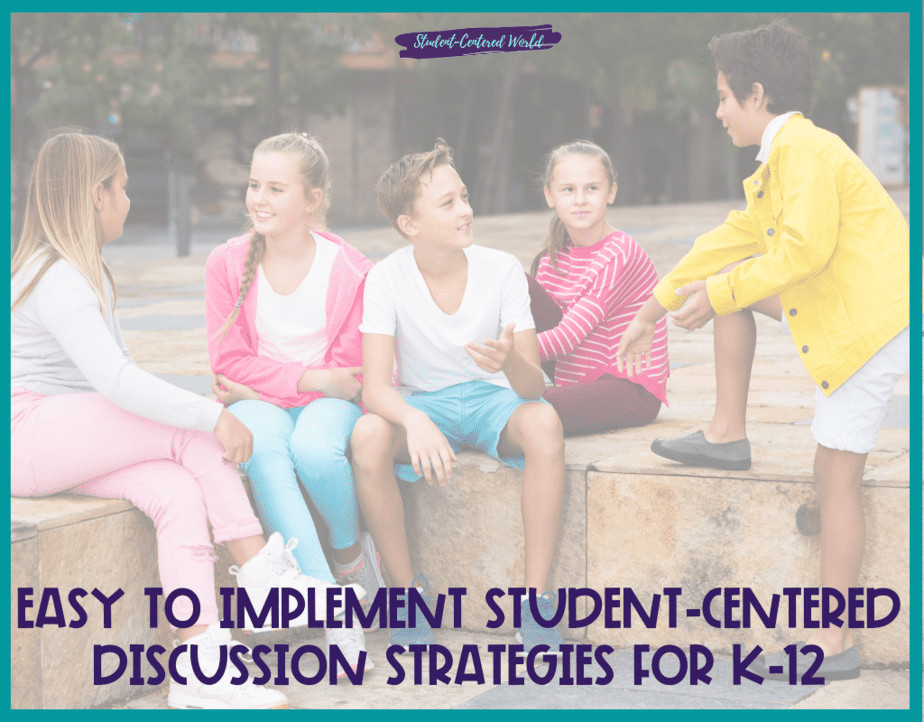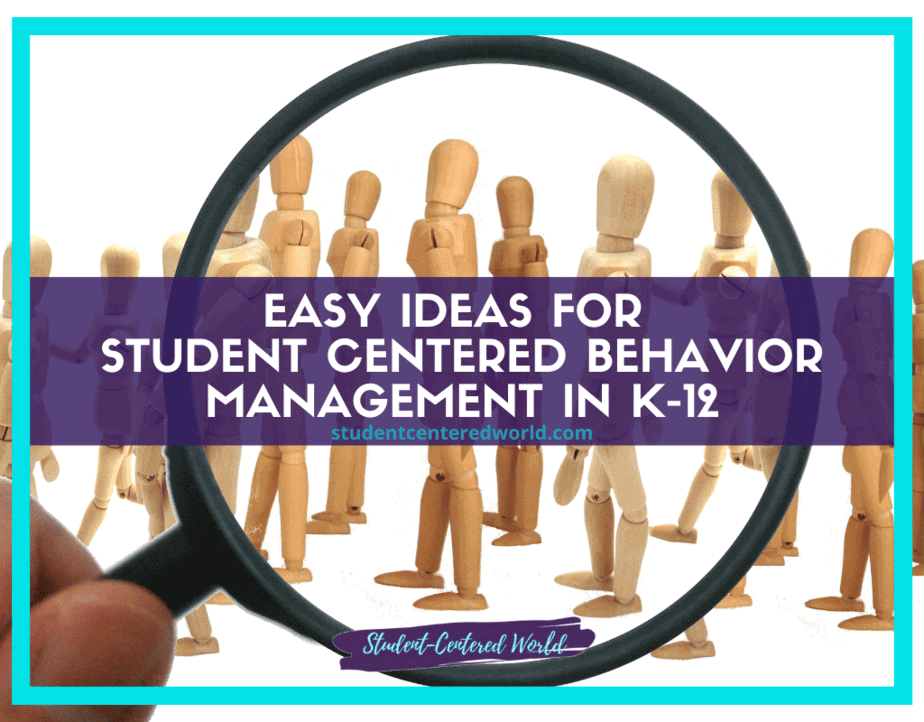Easy to Implement Student Centered Discussion Strategies for K-12
Teachers often get nervous when looking into student-led learning because with the “disappearance” of teacher lecturing, there is much confusion about the role of conversation and discussion in the classroom. Student centered discussion strategies are absolutely vital to have this method of instruction work to its fullest capabilities, and there are several ways to go about implementing them in the classroom.
I am going to share my absolute favorite student centered discussion strategies. Ones that have proven successful time and again on countless occasions with students of all kinds. I will preface this article by saying that there are several different ways you can implement student-led discussions into your courses. These are just a few of many ways, and you should use them as a guide to help inspire your own ideas.
What are student centered discussion strategies?
Student centered discussion strategies are classroom interactions that guide students to take the lead of their own learning. It is important for both teachers and students to act as facilitators rather than lecturers so that conversations will naturally result in student-centered learning.
There are many different ways to have students lead discussions in the classroom. Some examples include having students list out the criteria for what they are learning about before starting, using Socratic Seminars to have students ask each other questions rather than answering them and having groups of students work together to solve problems. Having well-defined strategies for the conversation gives both teachers and students a chance to practice being facilitators rather than lecture-style speakers, which is a vital part of student-centered learning.

How Do You Use Student Centered Discussion Strategies Effectively in the Classroom?
Involve students! The more students are invested in leading class discussions, the more they will take away from the conversation. Having some type of small group work before starting conversations can help to have students take more ownership.
For example, have groups of 3-4 students come up with the criteria for what they will be learning about so that they can be aware of it before beginning.
If you are leading a discussion question with your class, try doing Socratic Seminars where you pose a question to the class and have them take turns answering it rather than having one student answer it for everyone.
Having students work with each other in groups on problems that they need to solve is an excellent way of leading conversations with student centered discussion strategies because if each student contributes, their own learning process will increase and they will feel more of a sense of belonging in the classroom.
1) Start with the basics:
Before I begin teaching any new concept in class, students must have a very firm grasp of all vocab needed to understand this topic. I will spend several minutes going over key vocabulary words that are essential to understanding the concept, and I will even have students write these words down. If I am teaching about something that is very abstract, I will spend more time on the vocabulary before having student-led discussions or lectures of any kind. A good way to do this is by making several key vocab terms into anchor charts for students to refer back to.
2) Socratic Seminar:
Socratic seminars are a great way to have students practice being facilitators in conversations without actually having them lead them. Instead, the teacher poses a question and the class has a discussion about it in a round-robin style where each student talks for a set amount of time before rotating to the next student. I love doing seminars because it forces students to listen actively and interact with each other without being able to pick up their phones or have side conversations.
For example, I will pose a question that is designed for students to discuss together in order to figure out an answer rather than having me give the answer outright. The questions I pose are basic, but students need to work together to find the answer instead of working alone.
Students should be allowed to take notes during seminars to help them take active notes. I also advise having students go back to their desks after a few rotations in seminars because it can be distracting for other students if one student doesn’t participate while another is talking the whole time.
3) Problem Solving:
Finally, problem-solving is an essential part of leading discussions because it gets students thinking critically about the material that they are learning. The problems that I use in class should be thought-provoking and students should not be able to solve them on their own unless there is instruction for teaching them to do so. Instead, students should work together in order to figure out the problem because each student will learn something by taking turns trying to solve the problem.
For example, I have my students write a list of things that they want to learn about in class on a sticky note and put it on their desks. At the end of each class period, we go over this list as a class and come up with one thing to do as homework for tomorrow so that everyone will be prepared for what we will learn about next.
By having students lead discussions, they are able to take ownership of the learning process. This way of teaching is not only beneficial for student engagement but also for critical thinking skills and keeping students interested in the material that they are learning about. Teaching students how to facilitate good group conversations can definitely help to hold their attention and support them in gaining new knowledge.
What Are Some Other Student Centered Discussion Strategies?
Asking students to assess their own learning before starting class is an excellent way to have them take ownership of what they are learning about and reflect on it after.
Another student centered discussion strategy that teachers can implement is allowing for “living documents” in the classroom. A living document is an excellent way of allowing students to track their own learning and take notes on it for future reference.
Having students create a “learning contract” that they can then put into their own words rather than write directly from the teacher is another effective student centered discussion strategy. The more ownership students feel over what they are learning, the more they will take away from class.
More student centered discussion strategies are using small groups, not lecturing
A learner-centered classroom doesn’t mean the teacher goes by the wayside. A great way of implementing student centered discussion strategies includes the proper usage of small group instruction.
Having groups of 3-4 students work on problems or discuss topics with each other will allow for them to take the lead in their own learning while you are there as a facilitator. When teachers can facilitate small group work, they are actually better able to assess student understanding rather than lecturing to the whole class about what they need to know.

Start Small and Have Fun with your student centered discussion strategies!
Finally, take it slow at first. It can be overwhelming to implement student centered discussion strategies all at once in your classroom. Use this as a chance to try something new that will engage students rather than intimidate them. If you start small, students are more likely to enjoy themselves while learning and become invested in their own learning.
Another option that teachers have is to start a discussion with a couple of student volunteers and go from there. It can be as simple as, “I am going to share something with you now. If I’m doing it right, please tell me.”
Remember that engaged students lead to engaged discussions! And engaged discussions lead to higher-level thinking and learning.
Student centered discussion strategies can be extremely useful tools in any classroom to get students involved in their own learning process and help them work together to take ownership of their learning. Whether you are looking for how to use small group work before class, having students assess themselves, or using living documents, there are many ways to implement this into your classroom that will give you and your students a chance to practice being facilitators rather than just speakers.
What Are Some Tangible, Effective Student Centered Discussion Strategies?
Socratic Seminar:
This strategy can be used to foster a discussion that capitalizes on student expertise, engages students in thinking critically about the material, and allows for meaningful discourse. The teacher poses a question or problem to be discussed and provides time for the team to discuss the issue and prepare a response. The teacher then asks students to share out, beginning with team members who have not spoken. In subsequent iterations of the Socratic Seminar, students could be asked to take turns responding or rotating roles as discussants and responders.
Team Problem-Solving:
Here teams come up with solutions for a given problem and then present these to the rest of the class. Team Problem Solving allows for students to take ownership of their learning and engage in higher-level thinking without having to do so alone.
Peer Instruction:
In this strategy, students work in groups to discuss a question before the teacher provides feedback. This method is used to allow students to practice working together and thinking critically about a topic. The benefits of peer instruction include improved student engagement and increased retention of material for both students who teach as well as those who are being taught.
Meta-Cognitive Reflection:
This strategy has students think about their own thinking. In doing so, they can reflect on whether or not they are comprehending the material and make adjustments accordingly. This strategy allows students to take ownership of their learning and also keep track of their progress throughout a unit.
Inquiry Journals:
Inquiry journals are usually used in higher education. However, there are ways they can be adapted to fit lower grade levels as well. Inquiry journals allow students to reflect on their own learning and make connections between the material they are learning and the real world. This method is particularly helpful because it allows them to take ownership of their own learning.

Living Documents:
These are documents that change over time as students learn. They can include maps, web pages, timelines, etc… These allow students to take ownership of their learning and document their progress rather than just filling in blanks on a worksheet. Great for visual learners!
Classroom Conferences:
Students can use this strategy with a partner or in small groups to discuss the material without the teacher and assess their own understanding.
Small-Group Work:
This is a simple and effective way to have students work together on an assignment or problem that does not necessarily require whole-class discussion. This allows students of all abilities to participate, provides opportunities for students to ask questions, and also allows for greater student engagement.
Stop Driving the Teacher Struggle Bus
Are you struggling with student engagement, apathy, or keeping your class on track?
💫💫 There’s hope! 💫💫
Join my free teacher workshop “Choosing Choice” and in just 60 minutes, you’ll craft a practical plan to revitalize your teaching. Discover the magic of student choice in boosting engagement, gain quick implementation ideas, and explore strategies for year-long success.
Unlike overwhelming workshops, my approach guides you in real-time, providing more classroom options, reducing stress, and giving you more personal time.
Plus, you’ll earn a 1-hour professional development certificate and have 7 days of access.
Don’t miss this chance to transform your teaching; click below to secure your spot now!






